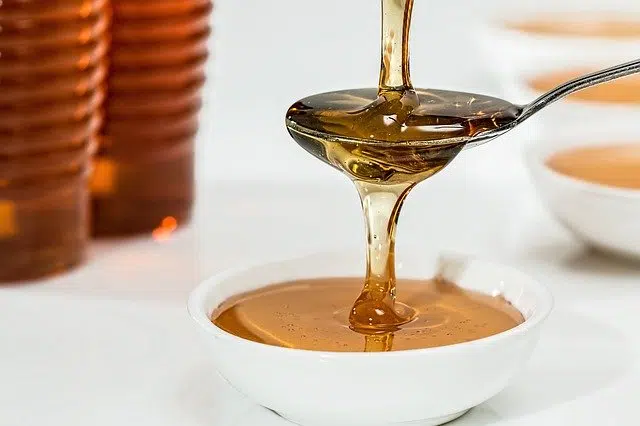
Glucose, present in honey and other substances, is a monosaccharide.
A sugar that cannot be decomposed into a simpler sugar by hydrolysis is called a monosaccharide . To understand precisely what a monosaccharide is, therefore, you must first be clear about what certain terms refer to.
Sugars are carbohydrates (also called carbohydrates or carbohydrates ). These are crystalline substances soluble in water that are characterized by their sweetness and by presenting a whitish hue in their pure state.
Hydrolysis or hydrolysis , on the other hand, is the process of splitting a molecule that is carried out through water . That molecule subjected to hydrolysis is fragmented into units of lower complexity.
Properties of a monosaccharide
Returning to the idea of monosaccharides, they are carbohydrates that, when subjected to hydrolysis, do not decompose. Known as simple sugars , they are considered the simplest carbohydrates.
A monosaccharide has between three and seven carbon atoms. One of those atoms is bonded to a carbonyl group , while all the rest are bonded to an alcohol group .
Monosaccharides are monomers (molecules with a reduced molecular mass). The union of several monosaccharides in a polymerization process gives rise to polymers called polysaccharides .
Other features
Another characteristic of monosaccharides is that their carbon chain does not branch, and that only one of their various carbon atoms does not contain an alcohol group. The carbon chain is understood to be the skeleton of almost any organic compound ; It consists of a group of carbon atoms with a carbon-carbon covalent bond, to which more atoms can be added or joined, such as nitrogen, oxygen or hydrogen.
As mentioned above, the atom different from the rest joins a carbonyl group , a concept that is also known as a carbonyl functional group and is a functional group formed by a carbon atom and an oxygen atom, joined by a double link.
If the carbonyl group is at the tip of the chain, then it is called an aldehyde group and the monosaccharide is called aldose . On the other hand, when the carbon is in another position, it is called ketone and the monosaccharide, ketose .

Fructose from fruits is another well-known monosaccharide.
Monosaccharides are reducing sugars
As a general rule, we can say that monosaccharides are reducing sugars , because they have at least one free hemiacetal hydroxyl. For this reason, tests such as Maillard or Benedict reactions , or Fehling or Tollens reagents always give positive results.
To express this characteristic of monosaccharides, it can also be stated that they have equilibrium with the open form, mutarotation or that they form osazones. The names that aldoses receive according to their number of atoms, starting with those with three and reaching those with six, are the following: trioses, tetroses, pentoses and hexoses .
Just like disaccharides, a class of carbohydrates that are formed when two monosaccharides are joined by an O-glycosidic bond, monosaccharides are sweet, crystalline and water-soluble. All simples have at least one asymmetric carbon. Glyceraldehyde is the simplest; Given its center of asymmetry, two isomers can be formed, D or L.
The way to distinguish these two isomers consists of representing their formula in the Fischer projection and paying attention to the penultimate carbon, the asymmetric one least close to the functional group.
Glucose and other examples
Glucose is the best known monosaccharide. This substance is present in honey and fruits, for example. The catabolic oxidation of said monosaccharide provides energy to the cells of living beings.
Fructose , galactose , altrose , and erythrose are other monosaccharides, each with their distinctive characteristics and properties.
